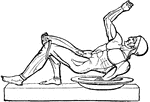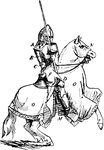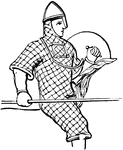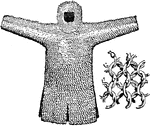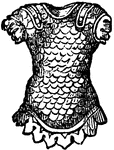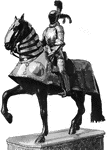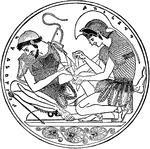
Écu
"The shield carried by a mounted man-at-arms in the middle ages; especially, the triangular shield of…

Épaulière
"In armor, the devices, more or less elaborate according to according to the period, etc., serving to…

A Frankish Chief in Full Armor
A chief of a Frankish tribe, wearing full battle armor. He stands looking to his right holding a long…

A Roman Soldier, or Legionary, with a Short Javelin and Shield
Illustration of a Roman soldier, also called a legionary, carrying a shield, short sword, and a short…

Aegis
"A breastplate covered with metal in the form of scales, not used to support the shield, as was done…
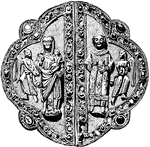
Agraffe
"A clasp or hook, used in armor or in ordinary costume, fastening in the same manner as the modern hook…

Agrenon
"A net-like woolen garment worn by bachanals and soothsayers in ancient Greece. Image: Toso of Apollo…

Aigret
"A plume composed of feathers arranged in imitation of the feathers on the head of the heron, and worn…

Ailette
"A plate of iron worn over the mail to protect the shoulders of a man-at-arms, before the introduction…

Allecret Armor
A knight wearing Allecret armor, which was typically worn by the Swiss in the 16th century.

Almain-rivet
"One of a series of short pieces of metal sliding in slot-holes formed in overlapping plates of armor,…

Arbalister
"One armed with the arbalist; a crossbowman; especially, a soldier carrying the arbalist of war."-Whitney,…

Arma
"Homer describes in various passages an entire suit of armour, and we observe that it consisted of the…

Arma
"Homer describes in various passages an entire suit of armour, and we observe that it consisted of the…
Armor
Full armor from a brass of Sir John de St. Quintin, 1397. KEY: 1-helmet, 2-visor, 3-gorget, 4-breast-plate,…

Armor
Full armor from the beginning of the 16th century. KEY: 1-helmet, 2-visor, 3-gorget, 4-breast-plate,…

Armor
"Complete suit of Plate-Armor, now in Paris, date about 1440- the epoch of greatest perfection of defensive…

Sirs John de Creke and John of Eltham Wearing Armor
Sirs John de Creke and John of Eltham wearing armor during the fourteenth century. The illustration…
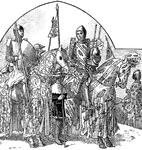
Knights and Noblemen on Horses Wearing Armor
The illustration shows two knights riding on horses. The knights and noblemen wore surcoats to hide…
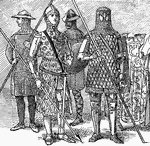
Men at Arms Wearing Armor
An illustration of men at arms wearing iron body armor. The illustration shows armors varied by wealth…

Siris Bronze Armor with Greek Warrior and Amazon
A decorated shoulder piece from a Greek bronze armor, known as Siris Bronze. The shoulder piece has…
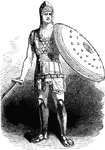
Arms and Armor
The image of a Roman legionnaire. He is equipped with a dense breastplate, a helm, a large round shield,…

Brass Armor
"Brass Armor of Richard Beauchamp, earl of Warwick." — The Encyclopedia Britannica, 1910
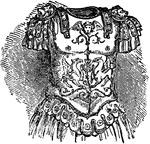
Breastplate
A breastplate is a device worn over the torso either to protect the torso from injury, or as an item…
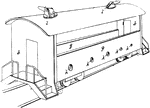
Military Railroad Car
An armoured train is a train protected with armour. Usually they are equipped with railroad cars armed…

Chivalry and knight-errantry
"The chivalry of the gothic nations began in the woods of Germany. No youth was then permitted to assume…
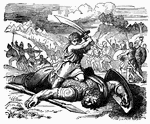
David Slays Goliath
"And it came to pass, when the Philistine arose, and came and drew nigh to meet David, that David hastened,…

Diving-dress and diving-helmet
The diving dress in a rubber suit with a metal helmet, having pieces of glass in front to enable to…

Enarme
"Inside View of Shield, showing Enarme, or Gear. Enarmer, provide, as a shield, with straps." -Whitney,…

Epaulet
"The shoulder-piece in the armor of the fourteenth century, especially when small and fitting closely…

Epaulet
"The shoulder-piece in the armor of the fourteenth century, especially when small and fitting closely…

Full Plate Armor
"Suit by Jacob Topf, nearly complete; the gorget does not belong to it." — The Encyclopedia Britannica,…

Soldier Wearing a Gambeson
A man wearing a gambeson from about 1375. A gambeson is a quilted padded jacket worn as armor.

Garde-Brace
"A piece of armor protecting the arm; properly, an elbow piece, but sometimes loosely used for the entire…
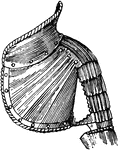
Garde-Collet
"In armor, a raised and ornamental ridge terminating the pauldron on the side toward the neck, and intended…

Gauntlet
The Gauntlet is a piece of protective armor for the hand, dating back to the 12th century. The first…
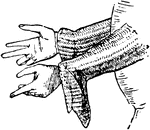
Gauntlet of Mail
"Gauntlet of mail forming part of the hauberk, 13th century. In medieval armor, a glove of defense."…

Gauntlet of Plate
"Gauntlet of plate, early 14th century. In medieval armor, a glove of defense." -Whitney, 1911

Gauntlet of Plate
"Gauntlet of plate, later 14th century. In medieval armor, a glove of defense." -Whitney, 1911
